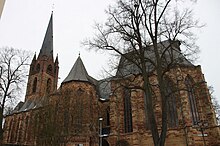Liebfrauenkirche (Frankenberg an der Eder)
The Liebfrauenkirche is a church building in Frankenberg in the Waldeck-Frankenberg district in northern Hesse .
history
The three-aisled Church of Our Lady was built in Gothic style in 1286 based on the model of the Elisabeth Church in Marburg . It is believed that the entire construction works moved from Marburg to Frankenberg in order to build the church there at the request of Landgrave Heinrich I , the grandson of St. Elisabeth . A memorial stone in the entrance area reads: "In April 1286, Landgrave Heinrich the child laid the foundation stone for this church" . The church was consecrated to “Our Lady, the Mother of God” . With a length of 60.40 m, a total width of 17.40 m and a 61.30 m high tower, a church with considerable dimensions was built.
The most valuable part of the church, the attached Marienkapelle des Tyle von Frankenberg with its 6.50 m high stone altar wall, was completed around 1380. The probably valuable and extensive initial equipment was completely destroyed in a devastating fire in 1476. The chronicler Wigand Gerstenberg , who was an eyewitness to this catastrophe, reports in his chronicle:
- “Now the fire started on the parish church, first on the small tower on the choir. This tower was completely covered with lead; that melted everything away, so that lead ran out of the area around the water villi, as if it were raining. At last the lead coagulated and clung to the villi like icicles a man's length. And now the fire rose on the ridge tree and burned down to the choir. Then it went on to the Church and the Chapel of Our Lady. That burned everything. Next it came to the great tower. Then the delicious good bell burned, which had fame all over the country in Hessen and beyond. In addition, others burned good bells, so that seven good bells burned in the parish church. Great damage was also done to the glass windows because the lead and solder melted and fell off. After that, probably around midnight, a number of young learned journeymen came with great difficulty through the fire to the parish church and wanted to see how things had gone there with the shrine and other things. Then glowing coals and fire fell from above through the holes in the vault and fell on the altars, on the pews, on the organ and on the clock, which began to glow. Then the journeymen took the holy water from the basin and used it to extinguish. "

After the fire, Landgrave Heinrich III called. all over Hesse to donate to rebuild the church. In 1478 the vault was decorated with ceiling paintings, which were painted over over the centuries, but were exposed again during a restoration in 1957. The individual yokes are painted with green tendrils and colorful flowers. In between there are guild signs indicating that the guilds are helping to rebuild. A small figure of Mary with a child can still be seen in a vaulted gusset .
After the Reformation in Hesse, the church became a Protestant church. Under Landgrave Moritz , who, due to his Reformed creed, rigorously enforced what he saw as the biblical ban on images and had statues of saints and other Christian representations destroyed in all churches in his country, numerous art treasures were irretrievably lost in 1606. Some of the rescued figures are now in the district home museum of St. Georgenberg Monastery , as are the beam heads carved by Philipp Soldan in the gallery, which was expanded in the middle of the 19th century. Particularly worth seeing today in the choir of the church are the panes with Gothic stained glass from the middle of the 14th century, the relief-like representation of the Gethsemani history , the sacrament house , the stone pulpit from 1554 and the ceiling paintings.
organ
The Seuffert organ from the dissolved Grafschaft monastery was replaced in the 20th century by the large organ made by the Frankenberg organ building company Wolfgang Böttner (built in 1970/71) with 2950 pipes . The slider chests -instrument has 41 registers on three manuals and pedal . The register action is electric.
|
|
|
|
|||||||||||||||||||||||||||||||||||||||||||||||||||||||||||||||||||||||||||||||||||||||||||||||||||
literature
- Georg Dehio, Handbuch der Deutschen Kunstdenkmäler , Hessen I, administrative districts Gießen and Kassel, founded from the Day of Monument Preservation 1900, continued by Ernst Gall, edited by Folkhard Cremer, Tobias Michael Wolf and others, 2008, Deutscher Kunstverlag, Munich, Berlin, ISBN 978 -3-422-03092-3
Individual evidence
- ^ The chronicles of Wigand Gerstenberg von Frankenberg. Edited by Hermann Elwert, Marburg 1909, urn : nbn: de: hbz: 061: 1-14071 ; Reprint: Elwert, Marburg 1989, ISBN 3-7708-0911-4 .
- ↑ Information about the organ on the website of the parish
Web links
- State Office for Monument Preservation Hessen (Ed.): Evangelical Church of Our Lady In: DenkXweb, online edition of cultural monuments in Hessen
Coordinates: 51 ° 3 '31.3 " N , 8 ° 47' 57.1" E




